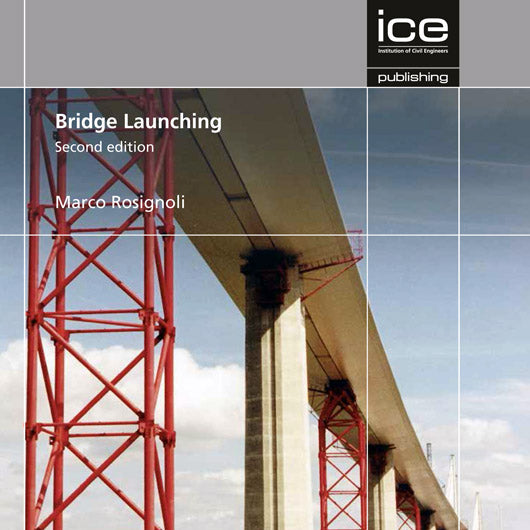
Bridge Launching, 2nd Edition
Marco Rosignoli
ICE Publishing, ISBN 9780727759979 (2014), p.376, available for purchase:
- At icebookshop.com/ISBN=9780727759979
- By email at orders@icepublishing.com
- From alternate online retailers such as Amazon
Bridge Launching was published by Thomas Telford in 2002, found widespread interest worldwide, soon became the international reference in the field, and was cited in a great number of researches and publications. Much has been done in the field of bridge launching since 2002, and the book required updating in many aspects. So, in 2014 I rewrote the book from scratch for ICE Publishing (the Institution of Civil Engineers, London, UK). The book has increased in size by one-third. In addition to my work experience on 34 launched bridges, I consulted more than 300 publications for this brand-new book.
The second edition of Bridge Launching provides state-of-the-art coverage of the design and construction of launched bridges made of steel, prestressed concrete, and prestressed composite construction with steel corrugated-plate webs. In addition to incremental launching, the book now covers deck rotation, jacking, skidding, and the launch of single spans, bowstring arches and cable-supported decks.
The book integrates the structural, aesthetic and economic aspects of construction techniques for building state-of-the-art structures, offering explanation of both the theoretical and technical aspects of the construction process. It illustrates the history of the incremental launching method with dozens of case studies that range from the first macro-segmental decks displaced with discontinuous launching on mobile bearings to the modern incremental deck casting technologies and the launch of beam bridges, continuous decks over arches, and cable-stayed decks over temporary piers.
Key methods for the structural analysis of launched bridges and design tools aimed at optimizing structural design and construction technology are developed and discussed with case studies. The Reduced Transfer Matrix (RTM) method for launch stress analysis now covers rectilinear and circular beams, and a special frame element with sliding support has been formulated for finite-element analysis of bridge launching with customizable structural analysis programs.
Design optimization tools for the nose-deck interaction and the front cable-stayed systems and a closed-form approach to the analysis of the torsion-distortion interaction generated by misaligned launch bearings are formulated and compared with finite-element analysis and statistical data of dozens of launched bridges. Optimization of nose-deck interaction, loads on temporary and permanent piers, launch and end-of-launch integrative post-tensioning, and launch stability of built-up I-girders and steel corrugated-plate webs are thoroughly discussed.
The second edition of Bridge Launching explores alternative static systems for launched bridges and the different techniques to increase or diminish the level of deck redundancy on launch completions. It explains the use of incremental launching technology in seismic regions and the geometry restraints of incremental launching, side skidding and deck rotation.
- Marco Rosignoli has proposed brand-new analysis and design methods for launched bridges, new technological solutions, innovative construction techniques, new casting sequences, new organizational schemes. All of this work is absolutely original simply because Marco Rosignoli is making the history of this construction method - Roberto Capozucca, Prof.Ing., Dr.Ing., Professor of Structural Engineering, Universita' Politecnica delle Marche (Italy)
- Many of the bridges designed and built by Marco Rosignoli have made the history of the incremental launching of bridges in Europe, and his outstanding research contribution has further contributed to the diffusion of this construction method - Giuseppe Matildi, Prof.Ing., Dr.Ing., Professor of Structural Engineering, Universita' di Bologna (Italy)
- Bridge Launching was an excellent book. The 2nd edition was much awaited for too long - Venkataramana Heggade, Senior Vice President, Special Bridges, Gammon India (India)
Pre-sizing techniques and alternative approaches to deck segmentation, cage prefabrication, design of launch post-tensioning and organization of the casting yard are analyzed and compared. Casting stages and launch techniques are described along with assessment of design assumptions by means of field monitoring and data recording. The launch stress redistribution caused by the time-dependent behavior of concrete is thoroughly explained. Prestressed-concrete bridges include cast-in-place and precast segmental structures, and steel bridges now include all types of cross-sections.
The book provides state-of-the-art treatment of prestressed composite bridges with steel corrugated-plate webs and the thrust systems and sliding bearings used for their incremental launching construction. The book formulates new criteria for optimized segmentation of steel girders and new on-site welding techniques employing robotized profile-tracking equipment for their field splices, as well as new process simulation techniques for segmentation optimization of steel and prestressed-concrete decks.
State-of-the-art analysis tools are formulated for local buckling and torsion-flexure instability of stiffened and corrugated-plate webs and the design of launch noses, front cable-stayed systems, temporary piers and sliding launch bearings for welded girders. Incremental launching of continuous strips of concrete slab over pre-launched steel girders is also discussed and compared with in-place casting with forming carriages.
Launch bearings, guide systems, thrust systems, launch forces, and displacement control systems during uphill and downhill launching are discussed for the different types of construction along with their design and technological requirements. The use of hydraulic launch bearings and skidding shoes is also explained to minimize the limitations of non-launchable deck geometries.
Offering explanations of the theoretical and technological aspects of the construction process, the second edition of Bridge Launching illustrates worldwide case studies with photographs and diagrams of state-of-the-art structures.
